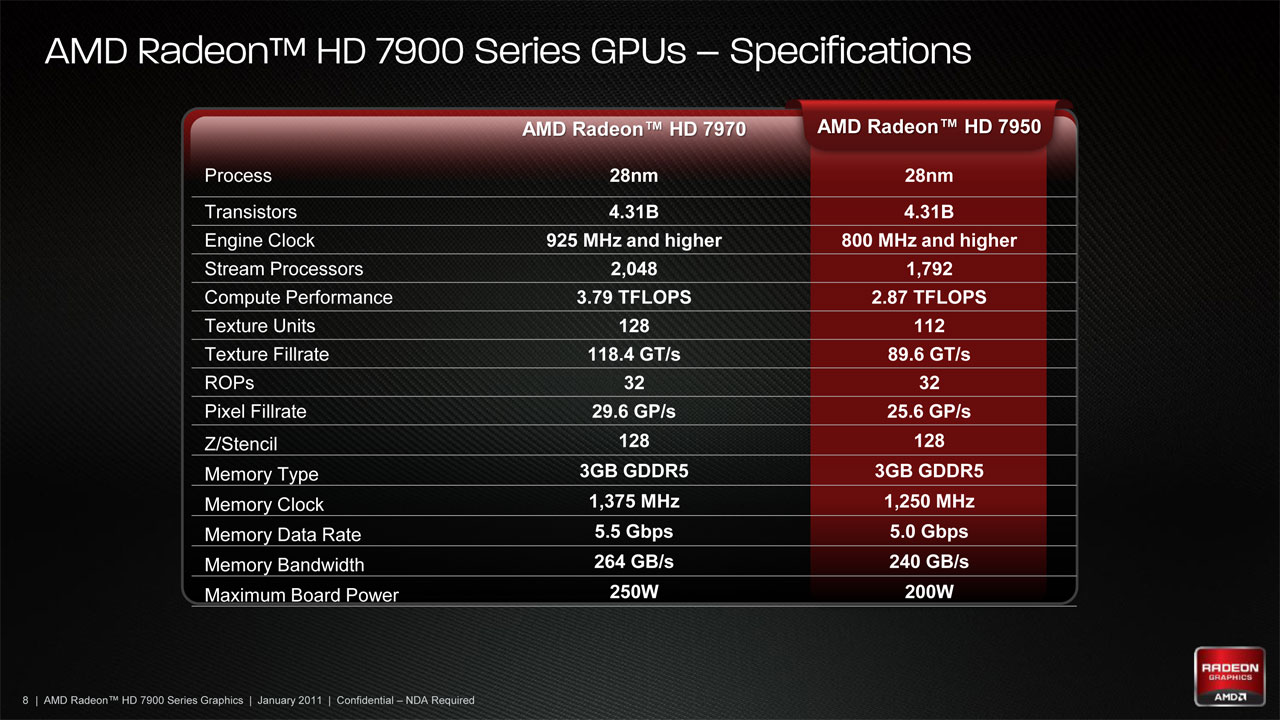AMD Radeon HD 7950 Review
AMD is following up the release of the flagship Radeon HD 7970 with the HD 7950. This card rounds out the top tier of the new Radeon HD 7000-series (The 7800 series will be the midrange tier, and the forthcoming dual-GPU card is in a class of its own).
The Radeon HD 7950 is a "familiar" launch. First, it follows the HD 7970 in maintaining all of the technical innovations introduced with the Radeon HD 7000-series (Graphics Core Next, Improved Fan, Dual BIOS, ZeroCore and Long Idle). Second it fills an expected slot under the flagship card with slightly reduced shader count, and slightly reduced clocks (much like the HD 6950 and HD 5850 compared to their "big brothers").
AMD is touting three "firsts" with the Radeon HD 7970. The first to a 28nm technology, the first to utilize PCI-Express v3.0, and the first with support for DirectX 11.1. While the move to 28nm pays immediate benefits in packing more transistors on the die, and lowering power consumption - the other two features will take time to be realized. For those who are interested in some of the architectural details, I've attached some slides below from the AMD press deck.



Specifications
The Radeon HD 7950 slots in just below the 7970, and like the 7970ups the ante in almost every regard versus the previous generation. It packs far more transistors onto the die, thanks to the 28nm process. Additionally, it ups the VRAM to 3GB, dramatically increases the shader count, and also increases the core clock. It does this for the same 200W profile of the Radeon HD 6950. Unfortunately, these improvements do bring a dramatically higher price.
| Card | GPUs | Transistors | Max Memory | Mem Bus Width | Shaders | Clock (MHz) | TDP (Watts)* | MSRP | ||
| Core | Mem | Idle | Max | |||||||
| AMD Radeon HD 7970 | 1 | 4.3B | 3GB | 384-bit | 2,048 | 925 | 1375 | <3 | 250* | $549 |
| AMD Radeon HD 7950 | 1 | 4.3B | 3GB | 384-bit | 1,792 | 800 | 1250 | <3 | 200* | $449 |
| AMD Radeon HD 6990 | 2 | 2 x 2.6B | 2 x 2GB | 2 x 256-bit | 2 x 1536 | 830 | 1250 | 37 | 350* | $699 |
| AMD Radeon HD 6970 | 1 | 2.6B | 2GB | 256-bit | 1536 | 880 | 1375 | 20 | 250* | $349 |
| AMD Radeon HD 6950 | 1 | 2.6B | 2GB | 256-bit | 1408 | 800 | 1250 | 20 | 200* | $279 |
| *These values represent the maximum wattage allowed through the AMD PowerTune. AMD estimates the average wattage draw for gaming is 190W/140W for the 6970/6950, respectively. Idle for the 7000-series is based on a "long idle" scenario. |
||||||||||
Overclocking
AMD is positioning the unit as having a large overclocking headroom. Even though the Engine Clock is reduced from 925MHz (in the HD 7970) down to 800 MHz in the Radoen HD 7950, AMD is still showing benchmark numbers at the 1GHz range. In addition their marketing slide deck for this release still contained the slide showing an operating range of 1GHz (and higher).


Power, Heat, Noise & Long Idle
One of the biggest updates with the new architecture is its improvements in power consumption, heat and noise. The improved fan design drastically improves the noise profile of the Radeon HD 7950. I run an open air case, and with the sytem in full benchmark mode, I couldn't discern the GPU noise over my CPU fan and my TV at low volume. Place this thing in an decent case, and it will be quieter than what most would expect.
Additionally, the 200W power draw is much cooler (at least 20%) than the 250W Radeon HD 7970. That translates into a much cooler operating temperature. I've dealt with the impact of high end cards raising the temperature in my office since I began benchmarking and testing. The temperature increase was far less noticeable this time around.
Finally I'm loving the Long Idle and ZeroCore improvements more and more. I use a Mac for my daily "productivity" usage (yea, yea, I know...), so I only fire up my PC for gaming. It was always frustrating to see how much heat was generated when I wasn't doing anything of any demand - downloading games on Steam is a perfect example. Now, with the power profile improvements, I can leave my machine downloading all night and wake to a still-cool office. Also, I wouldn't mind leaving my machine idling during the day so that I could jump into a game during my lunch break.

